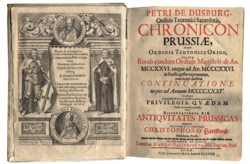Life

Peter's dates of birth and death are unknown, although he lived from the second half of the 13th century until the first half of the 14th century. Initially it was thought he was from Duisburg, Germany, and in some texts he is referred to as "Peter of Duisburg". Other research indicates he may have instead come from Doesburg, the Netherlands. [2]
In 1324, probably while in Königsberg, [3] Peter began working on his Chronicon terrae Prussiae on behalf of Grand Master Werner von Orseln. By 1326, he had finished expanding upon the now-lost work of a Latinist who had written about the campaigns of the early Prussian Crusade. [3] That version was subsequently revised to include events up to 1330. In 1331-1335, Nikolaus von Jeroschin translated Peter's chronicle into Middle High German on behalf of Grand Master Luther von Braunschweig.[ citation needed ]